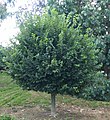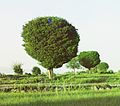Ulmus 'Androssowii'
| Ulmus 'Androssowii' | |
|---|---|
 Karagach [:black tree, = elm], Samarkand | |
| Genus | Ulmus |
| Cultivar | 'Androssowii' |
| Origin | Uzbekistan |
The hybrid cultivar Ulmus 'Androssowii' R. Kam. (or 'Androsowii'[1]), an elm of Uzbekistan sometimes referred to in old travel books as 'Turkestan Elm' or as 'karagach' [:black tree, = elm], its local name,[2] is probably an artificial hybrid. According to Lozina-Lozinskaia the tree is unknown in the wild in Uzbekistan,[3][4] and apparently arose from a crossing of U. densa var. bubyriana Litv. (:now Ulmus minor 'Umbraculifera'), which it resembles (see the disputed species Ulmus densa), and the Siberian Elm Ulmus pumila.[5]
Not to be confused with the U. turkestanica Regel distributed by the Späth nursery of Berlin.
For U. 'Karagatch', see 'Hybrid cultivars' below.
For so-called Ulmus androssowii var. subhirsuta C. K. Schneid. and Ulmus androssowii var. virgata (Planch.) Grudz. , see Ulmus chumlia.
Description[]

The tree grows to a height of 20 metres (66 ft) and is distinguished by its very dense spherical crown and pubescent leaves.[6] Its compact branch structure helps the tree conserve moisture.[7]

'Androssowii', Grange Farm Arboretum, Lincolnshire

Leaves of same
|
... In a garden near our sarai we saw some very fine karagach.[2][3] The karagach or Turkestan elm is one of the typical trees of the Duab landscape, chiefly owing to its tendency of forming leafy balloons of great regularity. As the main limbs shoot upwards like a bunch of flowers gradually unfolding near the top, and as the secondary boughs follow this example, the inner space of the cupola of foliage is a tangle of close-set ramifications which retains dead branches as well as the flotsam and jetsam of the air. As moreover short spikes and twigs grow out everywhere, the whole forms a disorderly nest of bark, leaves, sticks, and straws affording protection to many small birds. |
| – From Willi Rickmer Rickmers, The Duab of Turkestan, a physiographic sketch and account of some travels (1913).[8] |
Pests and diseases[]
Not known.
Cultivation[]
The hybrid has been widely planted in southern and western areas of the former Soviet Union,[9] notably along the streets of Samarkand. In western Europe it was distributed by Hesse's Nurseries, Weener, Germany, in the 1930s.[10] A specimen was present at Kew Gardens in the 1930s.[11] Cold-hardy, it prefers a rich soil and moderate humidity.

'Androssowii' left, U. Bubyriana [ Ulmus minor 'Umbraculifera' (?)] right, Samarkand (1903)

Turkestan Elm near Samarkand, early 20th century

Turkestan Elm near Samarkand, early 20th century

Photo captioned 'Umbraculifera' but possibly 'Androssowii', Bukhara, Uzbekistan (c.1910)
Hybrid cultivars[]
Ulmus 'Karagatch' is a hybrid cultivar from Turkestan, selected in the early 20th century and said to be either a backcrossing of U. pumila and U. 'Androssowii' or simply a cultivar of 'Androssowi'.
Synonymy[]
- Ulmus Androssowi: Litv. in Schedae ad Herbarium Florae Rossicae 8: 23, no. 2445, t.2, 1922.
- Ulmus pumila f. androssowii (Litv.) Rehd.
Accessions[]
- North America
- Morton Arboretum, Illinois, US. Acc. no. 353-72 (received as U. pumila f. androssowii (Litv.) Rehder).
- Europe
- Grange Farm Arboretum, Sutton St James, Spalding, Lincolnshire, UK. Grafted cuttings acquired 2013. Acc. nos. 1095, 1096.
- Hortus Botanicus Nationalis, Salaspils, Latvia. Acc. nos. 18165, 18166 (as U. pumila f. androssowii, both from Moscow).
- Sir Harold Hillier Gardens, Romsey, UK. Acc. nos. 2016.0355, 2016.0356.
Nurseries[]
- Europe
- Pan-global Plants [4], Frampton on Severn, Gloucestershire, UK.
References[]
- ^ Richens, R. H., Elm (Cambridge 1981), p.279
- ^ Rickmers, W. Rickmer, The Duab of Turkestan, a physiographic sketch and account of some travels (Cambridge, 1913), pp.172, 26, 63, 162, 166, 332
- ^ Sokolov (1951). Trees & Shrubs in the U.S.S.R (in Russian), 2: 506.
- ^ kiki.huh.harvard
- ^ Rehder, Alfred (1939). "Rehder, new species, varieties and combinations". Journal of the Arnold Arboretum. 20: 88–89. Retrieved 12 August 2016.
- ^ Green, Peter Shaw (1964). "Registration of cultivar names in Ulmus". Arnoldia. Arnold Arboretum, Harvard University. 24 (6–8): 41–80. Retrieved 16 February 2017.
- ^ World Digital Library, wdl.org/en/item/5747/
- ^ Rickmers, W. Rickmer, The Duab of Turkestan, a physiographic sketch and account of some travels (Cambridge, 1913), p.172
- ^ Photos of 'Androssowii', yvision.kz [1] (in Russian)
- ^ Hesse, Hermann Albert (1932). Preis- und Sortenliste. pp. 96–97. Retrieved 18 January 2018.
- ^ naturalis.nl, specimen L.1582323
External links[]
- Photographs of and information on 'karagach' in Uzbekistan, World Digital Library
- "Herbarium specimen - WAG.1846112". Botany catalogues. Naturalis Biodiversity Center. Formerly labelled U. pumila 'Androssowi' (Wageningen Arboretum, 1962)
- "Herbarium specimen - WAG.1846113". Botany catalogues. Naturalis Biodiversity Center. Formerly labelled U. pumila 'Androssowi' (Wageningen Arboretum, 1962)
- "Herbarium specimen - L.1582323". Botany catalogues. Naturalis Biodiversity Center. Ulmus, formerly mis-labelled U. angronovii (Kew specimen, 1935)
- Hybrid elm cultivar





